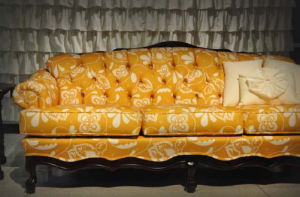Michelle Sorensen and Professor Adrian Pulfer, Visual Arts and Graphic Design
Pattern design is widely popular and used throughout the world. Patterns have also been used since the beginning of time. They can be seen in blankets, clothing, rugs, and paintings throughout history. For my study of patterns I looked to an unusual resource—ancient Egypt. Egypt has had immense influence in the modern world, from architecture to fashion. But I wanted to look at Egyptian art with the focus of patterns and the purpose behind their use. Was there calculated purpose behind the use of patterns? Or were they used to merely fill up space? Did the Egyptians have a unique way of creating patterns? And if so, can I use some of their same techniques in my own pattern design?
Through my research, I found that Egyptian artists did have a very unique way of doing things. Part of this was the fact that art back then was used for very different purposes than it is today. While our society sees art as more of a luxury, to the Egyptians it was a necessity. Their society was primarily illiterate, and art was one of the main ways that the Pharaoh was able to communicate with the commoners in his kingdom. Because of this, the artwork in ancient Egypt was very tightly controlled. Today, we may think of artists as “free spirits” who experiment with new ways to create their work. That was not the case in ancient Egypt. All of the artwork was commissioned and overseen by the Pharaoh and had strict guidelines to follow. In our day, we would probably refer to these artists more often as “craftsmen”. This is perhaps why their work has such an astonishing quality to it. They had a unique style that was passed on for many generations. Any changes in their artwork were very gradual.
Symmetry and geometry is very prevalent, as is the depiction of common plants and animals that were in their area. A defining characteristic of their artwork is that they created the plants and animals in a very graphic, modern way. Instead of trying to recreate a very lifelike appearance, they emphasized the recognizable characteristics of plants and animals.
The other major theme throughout their work was that it was driven by religious purposes. This is a natural theme for their work to follow since religion was completely intertwined with their daily life, and their Pharaoh was their political and religious leader and, essentially, their “art director”.
Now, patterns were frequently used in Egyptian artwork, but there isn’t any real evidence that the patterns themselves had great religious significance. It is believed that the Egyptians did see great blank spaces in their work as “unsightly”, and they filled much of it with patterns. However, just because the pattern work didn’t have great significance, doesn’t mean it was done as an afterthought. As I studied the patterns in murals and tombs from the Egyptian time, it is apparent that they were executed with great care. I found studying the patterns exciting, because since it is believed that they don’t have religious significance, one can assume that patterns would have been one of the few parts of their artwork that wasn’t as strictly regulated and where the artists were able to display a bit of artistic freedom.
In my own work (which was on display in the HFAC from September 20-30, 2010) I created four different textile patterns. Each based on a different process taken from the Egyptians method of creating. The first I printed on reupholstery fabric which I then used to cover a vintage sofa. The sofa fabric was, as the Egyptians were, inspired by animals and plants that I have seen. I interpreted these plants and animals in a simplified, graphic way:

The other three patterns I created were used as book covers, and were displayed on a small table next to the reupholstered sofa. These were also created after the example of Egyptian patterns. The first is a geometrical pattern, the second was symmetrical and inspired by something in my day (tire tracks) and the third was another pattern that incorporates animals:

This project was an incredible learning experience for me. I didn’t discover exactly what I thought I would from studying Egyptian patterns, but have had valuable experience learning new ways to research work from other cultures, and apply their processes to my own. It was an invaluable lesson in the process of textile design, and I look forward to continuing my textile designs in the future.
A more in depth look at the research I did of Egyptian patterns can be found in the Graphic Design Visual Arts Department, c/o Eric Gillett.
